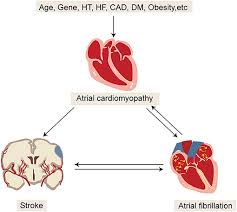
Atrial cardiomyopathy is defined as any complex of structural, architectural, contractile or electrophysiological changes affecting the atria with the potential to produce clinically-relevant manifestations.
Atrial cardiopathy is strongly associated with atrial fibrillation, and plays a role in thromboembolism related to atrial fibrillation.
Atrial cardiopathy is associated with the risk of ischemic stroke, even in the absence of clinical apparent atrial fibrillation.
Unrecognized atrial cardiopathy may explain some of the mini ischemic strokes that are classified as cryptogenic.
Four classes are defined:
principal cardiomyocyte changes
principally fibrotic changes
combined cardiomyocyte-pathology/fibrosis
primarily non-collagen infiltration, with or without cardiomyocyte changes.
These classes are not static and may vary over time.
In patients with cryptogenic stroke and evidence of atrial cardiopathy, without atrial fibrillation, apixaban and did not significantly reduce recurrent stroke risk compared with aspirin (ARCADIA atrial).
